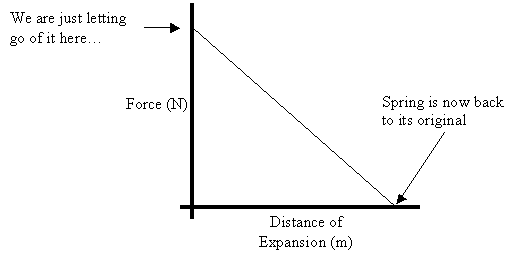Note-A-Rific:
Elastic Potential Energy
Any object than can be deformed (have its shaped changed) and then return
to its original shape can store elastic potential energy.
· We’re still talking about potential energy, since it is stored energy until the object is allowed to bounce back.
·
“Elastic”
does not refer to just things like elastic bands…other materials that would be
referred to as elastic would be
o
pole
vaulter’s pole
o
springs
o
cheese
(no, I’m just kidding. Just wanted to see if you’re paying attention)
You learned in Physics 20 that Hooke’s Law is…
F = kx
F = force (N)
k = spring constant for that object (N/m)
x = amount of expansion or compression (m)
We can use
this formula to figure out a formula for the energy stored in the spring.
·
Remember
that W = F d
·
We might
be tempted to just shove the formula for Hooke’s Law into this formula to get
W = kxd = kx2, but this is
wrong!
·
You
have to take into account that the force is not constant as the object returns
to its original shape… it’s at a maximum when it is deformed the most, and is
zero when the obect is not deformed.
·
Let’s
graph Force vs Distance of Expansion for a spring that was stretched and we are
now letting go of it…

But this is really just a Force vs Displacement Graph like the ones we
just looked at a couple of sections back! To figure out the energy of the spring
we can just figure out the work it does by looking at the area under the graph.
 Area = ½ bh
Area = ½ bh
=
½ F x
=
½ (kx) x
Area = ½ kx2 = W
So the work done by the spring (and then energy
it stored) can be calculated using…
Ee = ½ kx2
Ee = eleastic potential
energy (J)
k = spring constant (N/m)
x = amount of expansion or compression
[deformation] (m)
Example: How much energy does a spring with
a k constant of 15 N/m store if it is stretched by 1.6m?
Ee = ½ kx2
=
½ (15N/m) (1.6 m)2
Ee = 19 J